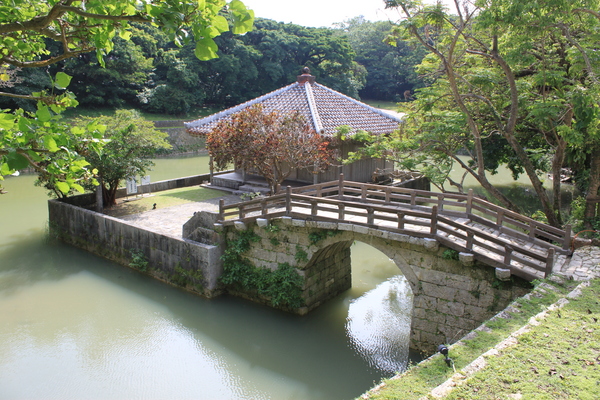Tennyo-bashi Bridge, Benzaitendou
Historic sitesHistoryShuri Castle Park


In the mid-15th century, during the reign of King Sho Toku, precious Buddhist scriptures were presented from the 7th king Riju of the Korean Dynasty. In 1502, in order to house the scriptures, by the order of King Sho Shin, Enkanchi Pond was built to have a temple on the island. The bridge over the island is Tennyo Bridge and it is also called Kanren-bashi.
Basic information
- Address
- 903-0812 1-2 Tonokura-cho Shuri Naha Okinawa In Shuri Castle Park
- TEL
- 098-886-2020 Okinawa churashima foundation Shurijo Castle Park Management Center
- Close day
- None
- Charge
- Free
- Parking
- Toll parking
- Access information
- Take the "Yui Rail" from Naha Airport. Get off at Shuri station. A 10-minute walk away. Take city bus line number (1, or 17), or the outside the city bus No. 46 line, and get off at Shurijo-kouen Iriguchi bus stop. About a 5-minute walk to arrive at Shurei-mon gate.
Take the Shurijo Shitamachi bus line number 8 and get off at Shurijo-mae bus stop, walk about 1 minute and arrive in front of Shurei-mon gate.
Take the number 9, number 25 city bus line, get off at Yamakawa bus stop, walk about 15 minutes and arrive at Shurei-mon gate. - URL
- http://oki-park.jp/shurijo-park/
Additional Information
- Barrier-free
- Academic information
- Cultural property(National designated architecture)
Designated date: May 15, 1972
In the mid-15th century, during the reign of King Sho Toku, precious Buddhist scriptures were presented from the 7th king Riju of the Korean Dynasty. In 1502, in order to house the scriptures, by the order of King Sho Shin, Enkanchi Pond was built to have a temple on the island. The bridge over the island is Tennyo Bridge and it is also called Kanren-bashi.
In 1609 when the Satsuma clan invaded the Ryukyu Kingdom, the temple was destroyed and the sculptures were lost. In 1621, the temple was reconstructed and Benzaiten-zo statue was moved to the hall for worship. Accordingly, the temple was called “Benzaiten-do” and the bridge, “Tenno-bashi.” In 1744, when the bridge was about to lean to one side, it was restored. At the same time, the bridge was too close to Benzaiten-do, which spoils scenery, so is was moved to the present location.
The bridge is 9.75m long in total and 3.28m wide. Built of Ryukyu limestone, it is a single arch bridge with a higher center. This type of a single-arch bridge with a higher center was common in the provinces where creeks were developed in southern China, so the Ryukyu Kingdom introduced the quaintness into the construction. Japanese wooden construction was introduced into the parapets and fine-grained sandstone called Niibinufuni. This has the characteristics of combining designs and techniques from China, Japan, etc. In 1945, the island had a bombshell land on it and was destroyed together with the Benzaiten-do. Tennyo Bridge slightly fell, but miraculously survived except for fallen parapets. In 1969, when the island and Benzaiten-do were reconstructed, Tennyo Bridge was also restored. - Quote
- Naha Board of Education Cultural Heritage Division (2007) "Naha Cultural Property" Naha Board of Education
